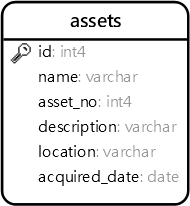August 2, 2023
Summary: This tutorial shows you step by step how to change the data type of a column by using the ALTER TABLE statement.
Table of Contents
PostgreSQL change column type statement
To change the data type of a column, you use the ALTER TABLE statement as follows:
ALTER TABLE table_name
ALTER COLUMN column_name [SET DATA] TYPE new_data_type;
Let’s examine the statement in a greater detail:
- First, specify the name of the table to which the column you want to change after the
ALTER TABLEkeywords. - Second, specify the name of the column that you want to change the data type after the
ALTER COLUMNclause. - Third, supply the new data type for the column after the
TYPEkeyword. TheSET DATA TYPEandTYPEare equivalent.
To change the data types of multiple columns in a single statement, you use multiple ALTER COLUMN clauses like this:
ALTER TABLE table_name
ALTER COLUMN column_name1 [SET DATA] TYPE new_data_type,
ALTER COLUMN column_name2 [SET DATA] TYPE new_data_type,
...;
In this syntax, you add a comma (,) after each ALTER COLUMN clause.
PostgreSQL allows you to convert the values of a column to the new ones while changing its data type by adding a USING clause as follows:
ALTER TABLE table_name
ALTER COLUMN column_name TYPE new_data_type USING expression;
The USING clause specifies an expression that allows you to convert the old values to the new ones.
If you omit the USING clause, PostgreSQL will cast the values to the new ones implicitly. In case the cast fails, PostgreSQL will issue an error and recommends you provide the USING clause with an expression for the data conversion.
The expression after the USING keyword can be as simple as column_name::new_data_type such as price::numeric or as complex as a custom function.
PostgreSQL change column type examples
Let’s create a new table named assets and insert some rows into the table for the demonstration.
CREATE TABLE assets (
id serial PRIMARY KEY,
name TEXT NOT NULL,
asset_no VARCHAR NOT NULL,
description TEXT,
location TEXT,
acquired_date DATE NOT NULL
);
INSERT INTO assets(name,asset_no,location,acquired_date)
VALUES('Server','10001','Server room','2017-01-01'),
('UPS','10002','Server room','2017-01-01');

To change the data type of the name column to VARCHAR, you use the following statement:
ALTER TABLE assets
ALTER COLUMN name TYPE VARCHAR;
The following statement changes the data types of description and location columns from TEXT to VARCHAR:
ALTER TABLE assets
ALTER COLUMN location TYPE VARCHAR,
ALTER COLUMN description TYPE VARCHAR;
To change the data type of the asset_no column to integer, you use the following statement:
ALTER TABLE assets
ALTER COLUMN asset_no TYPE INT;
PostgreSQL issued an error and a very helpful hint:
ERROR: column "asset_no" cannot be cast automatically to type integer
HINT: You might need to specify "USING asset_no::integer".
The following statement adds the USING clause to the above statement:
ALTER TABLE assets
ALTER COLUMN asset_no TYPE INT
USING asset_no::integer;
It worked as expected.
In this tutorial, you have learned how to use the ALTER TABLE ALTER COLUMN statement to change the type of a column.

